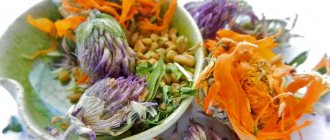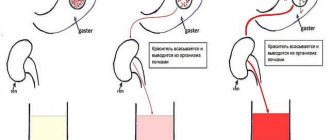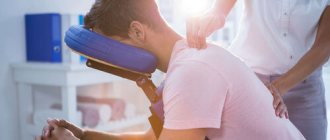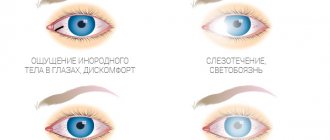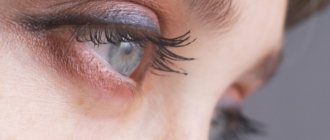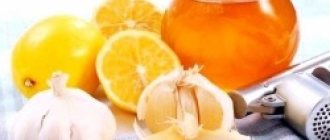Why does the main pressure increase?
When fluid metabolism is disrupted, when fluid presses on the eye from the inside, an increase in eye pressure occurs. There may be several reasons for the increase in pressure.
This disease can be the result of taking medications, including antidepressants and hormonal drugs. Another cause may be eye injuries. The danger in this case is that the injury may not manifest itself immediately, but after a few years it will make itself felt. If an eye injury occurs, it is better to regularly visit an ophthalmologist.
Increased pressure may occur due to inflammation of the eye. If you drink a lot of alcohol, smoke, or eat salty foods, this will cause eye inflammation. To prevent this from happening, you need to eat more vegetables and fruits, which will help avoid increased intraocular pressure. In order to see a doctor in time, you need to know the main symptoms of the disease.
Symptoms of glaucoma:
- Redness of the eyes that does not go away within a few days.
- Pain in the eyes, head. Especially when pressing on the eyes causes pain.
- Nausea may occur when your blood pressure rises.
- Decreased vision clarity, blurred vision, spots or spots may appear before the eyes.
Only a specialist can accurately determine glaucoma. If you have at least one symptom of glaucoma, you should consult a doctor as quickly as possible to prescribe treatment.
Diagnostics
Treatment of eye pressure cannot be carried out without diagnostic measures. Only by identifying the causes and manifestations can the correct therapy be prescribed to such a patient. There are several ways to measure this index, because without accurate indicators, an ophthalmologist will not be able to select pills for this disease.
- Palpation. Not all doctors can use this technique in practice, since you need to know the features of such a measurement. The doctor sits the patient with his back to himself, asks him to look down at the floor and close his eyes in this position. The specialist presses his finger on the patient’s eyes, finding out how elastic they are. If the elasticity is strong, then increased eye pressure is noted; if the elasticity is weak, this indicator is lower than normal.
- Measurement using a Maklakov tonometer. This tool is light in weight, about 5-15 grams and consists of 2 cylinders with a flat bottom. The patient lies down on the couch, and the doctor covers the bottom of the instrument with special paint, having previously treated the eyeball with an anesthetic substance. The cylinder is placed on the open eye, the cornea itself, and released. Afterwards, the doctor removes the instrument and makes an imprint of the painted bottom on a piece of paper. There is a special measuring scale that determines increased or decreased eye pressure.
- Measurements using a pneumotonometer. This device is a modern means of measuring eye pressure readings. The patient sits on a chair in front of the doctor with his eyes wide open, and the doctor directs a stream of compressed air into the eyeball, directly into the center of the cornea. The device immediately provides the result of such a measurement, and no anesthesia is required.
How to reduce it with medication?
To provide assistance in the treatment of glaucoma, you must consult a doctor. When pressure in the eyes increases, doctors often prescribe eye drops. Drops are divided into several types, including:
- drugs that constrict the pupils of the eyes, increasing the outflow of intraocular fluid;
- drugs that lower blood pressure;
- drugs that promote fluid drainage from the eyes.
To treat glaucoma, tablets can be used that give the same effect as drops. But unlike drops, tablets are more effective. In especially severe cases, when tablets and drops cannot cope with the task, the doctor may prescribe laser therapy. The therapy will improve the circulation of intraocular fluid.
During the treatment of glaucoma, the doctor prescribes one drug. If it does not help in treatment, then another, stronger drug may be prescribed. During treatment, the prescribed medications may not lower blood pressure; in this case, the doctor will prescribe other medications.
If there is still a risk of going blind while taking medications, the doctor uses complex treatment. In addition to special medications, the ophthalmologist may prescribe surgical intervention.
How to effectively lower eye pressure?
You can reduce eye pressure with drug therapy, as well as traditional methods of treatment. Medications are often prescribed in the form of eye drops, as they can reduce IOP more quickly.
Eye drops:
- Beta blockers reduce the production of fluid inside the eye, which helps lower IOP. These include Timolol and Betoptik drops.
- Prostaglandins: Xalatan, Travatan, Taflotan. The mechanism of action is to improve the outflow of intraocular fluid.
- Carbonic anhydrase inhibitors: Trusopt, Azopt. Drops can reduce the synthesis of intraocular fluid.
- Cholinomimetics: Pilocarpine, Carbachol. This group of medications helps reduce IOP by reducing the size of the pupil and improving fluid outflow.
The tablets used are "Acetazolamide" - a medicine against glaucoma, a diuretic. Removes excess fluid from the body, including the visual organ.
Video: 5 facts about eye pressure
Treatment with folk remedies
How to relieve high eye pressure using traditional methods? Home treatment with non-drug remedies effectively lowers eye pressure, which is important for people who have contraindications to medications.
- Potato compresses. Mix mashed potatoes with 1 tsp. 6% vinegar, put on a gauze napkin. Apply to closed eyelids for 15–20 minutes.
- Aloe decoction. Boil 5 leaves of the plant in 200 ml of water. Cook for 5–7 minutes. Cool and pass through cheesecloth. Use the resulting decoction to rinse the eyes.
- Many vitamins and minerals that are beneficial for the visual organs are found in parsley juice. Beetroot and carrots are useful.
- Herbal teas. Brew currant and rowan leaves with boiling water and drink tea daily. Tea is a diuretic and helps reduce swelling in the body.
- Massage the collar area. This will improve blood circulation in the blood vessels.
- Cold and hot shower. Direct a powerful stream of water onto your closed eyelids. To tone blood vessels and reduce IOP, alternate cold water with warm water.
Watch a video from Lyudmila Lazareva on how to restore intraocular pressure without drops and other drugs, using several tricks.
Video: Restoring vision
How to downgrade houses?
To lower your blood pressure yourself at home, follow these recommendations.
- Use a high pillow to sleep. It is important that the neck is not overstrained.
- When working at a computer, there should be appropriate lighting when reading. The monitor and book should be well lit.
- Frequent visits to movie theaters increase intraocular pressure. In this case, it is better to reduce the number of trips to the cinema.
- If you have high blood pressure, you should not wear clothes that are tight around your neck. Men are not recommended to tie their ties tightly or button the last button of their shirt, and women are not recommended to tie scarves too tightly.
- Doctors do not recommend bending low. All necessary items must be at such a level that the head is not lowered. So, when cleaning, it is better to use a mop that is long enough to clean almost while standing.
- When working at a computer, you need to make sure that your eyes do not strain, take breaks from work, and give your eyes a rest.
- Alcohol and cigarettes increase blood pressure. Therefore, exclude them from your diet.
- If there is increased pressure inside the eyes, you should not drink large amounts of liquid. So, minimize your consumption of coffee and tea.
- Your diet should include a sufficient amount of fresh fruits, vegetables, and dairy products. To reduce blood pressure, you need to exclude fatty, sweet, and salty foods from your diet.
- Be sure to play sports. Swimming is the best sport for intraocular pressure. When choosing another sport, be careful not to tilt your head too low.
- You need to regularly massage the area around your eyes. Massage movements should be light, do not press too hard.
- To optimize blood pressure, you need to take vitamin complexes.
- To be able to measure eye pressure at any time, purchase a tonometer.
The reduction in blood pressure can be influenced by the absence of stress. Calmness and the absence of stressful situations will help keep your blood pressure normal. By taking these recommendations as a rule, you will be able to lower and regulate your blood pressure yourself.
Symptoms
Signs of high pressure in the eyes may not appear at all if the tonometer reading is slightly higher than normal. Indicators that vary between 17-27 mm Hg are considered normal. pillar If this index is significantly higher, then the person will experience very unpleasant sensations similar to the symptoms of hypertension.
- intense headache, most often manifested in the temporal region;
- pain when moving the eyeballs;
- decreased performance due to constant fatigue;
- inability to read small print or watch television;
- redness of the eyes;
- blurred vision;
- pain and heaviness in the eyeballs.
If increased eye pressure is observed for a long time, then it becomes difficult for a person to work and perform normal activities.
The symptoms can be painful; severe headaches prevent one from living normally. Such manifestations serve as a signal to immediately visit an ophthalmologist, because the situation is becoming dangerous.
We must not forget about the decline in this indicator. If intraocular pressure, the symptoms of which are practically not felt, is less than normal, then the signs are difficult to see. In such people, the eyeballs noticeably sink, since the level of fluid washing the cornea is reduced. Relatives notice that the patient’s eyes have become dull and the vibrant shine has disappeared. A long period of low eye pressure can lead to atrophic changes in the tissue of this organ, and, as a result, to a complete loss of visual function.
Symptoms and treatment of this pathology can be different, and if the disease progresses, then its signs will be brighter and therapy more complicated. If you identify the disease at an early stage, it is much easier to eliminate it; an advanced stage of the disease can seriously impair vision, and treatment will be long and not always effective.
How to reduce intraocular pressure using traditional methods?
To treat glaucoma, you should consult an eye doctor who will prescribe a set of medications. You can also use traditional methods. But, you must remember that when using traditional methods, you cannot exclude medications prescribed by a doctor.
- To reduce pressure in your eyes, you can wash your face with aloe vera decoction every three hours. To make a decoction, take four aloe leaves, add 300 grams of water and cook for a few minutes.
- Nettle compress helps lower intraocular pressure. To do this, you will need half a glass of chopped nettle, with the addition of a teaspoon of crushed lily of the valley. Add a spoonful of water, mix thoroughly and use as a compress.
- Pour boiling water over a teaspoon of coriander and anise and drink the resulting liquid throughout the day. The next day you need to make a new infusion.
- Using woodlice, you can also fight high blood pressure. To do this, pour 100 grams of vodka into a liter of woodlice juice, stir and let it brew for several days. You should drink a quarter glass twice a day. You can drink the tincture with a glass of water.
- Include blueberries in your diet. You can consume it either fresh or in capsules.
- Juice from carrots, beets and parsley should be taken daily to relieve blood pressure.
- To lower blood pressure, you can make a mixture of potatoes and vinegar. Peel and chop the potatoes, add a teaspoon of vinegar, and leave the mixture to steep for thirty minutes. Take gauze, put the mixture on it and place it on your eyes.
- After squeezing out the celandine juice and adding the same amount of liquid honey to it, the mixture must be boiled over low heat. After the mixture has cooled, it can be used as an eye lotion.
- By drinking 100 grams of tomato juice daily, you can effectively reduce pressure in your eyes.
Knowing how to lower blood pressure at home, there is a chance that you will not have to seek help from a doctor.
General recommendations for home treatment
Treatment of eye pressure includes traditional and folk methods. In some cases, surgery may be required. Only an integrated approach to this problem will eliminate the unpleasant symptoms of eye pressure:
- frequent redness of the eyeball, which has nothing to do with visual stress or wearing lenses;
- headache;
- pain in the eye, which intensifies when pressed;
- attack of nausea;
- the appearance of spots before the eyes;
- blurred vision.
Ocular hypertension is a sign of glaucoma
Despite the fact that specialists can quickly remove hypertension, the problem itself that lies behind this symptom may remain
High blood pressure is a precursor to glaucoma, so it is very important to seek help from an ophthalmologist in time
Increased intraocular pressure is a characteristic symptom of glaucoma. Progression of the disease can lead to complete blindness. You can lower eye pressure with the help of medications. Patients may be prescribed drugs to improve the microcirculation of intraocular fluid, medications to reduce the production of tear substance, as well as drops that open alternative pathways for the outflow of fluid.
Drug treatment will be successful only if you adhere to certain rules:
- During sleep, the head should be slightly raised, for this you should choose high pillows;
- Monitor the light level in the room. Lack of light can worsen the condition;
- do eye exercises daily;
- In cinemas and similar places, intraocular pressure may increase, so you will have to avoid going there;
- Do not wear clothes with tight collars; leave the top button undone. Otherwise, the blood supply to the brain is disrupted, which also affects the condition of the visual apparatus;
- during physical activity, try not to tilt your head too much down;
- eliminate visual and physical overload;
- buy an eye tonometer. Using the device, you can take measurements at any time convenient for you;
- get rid of bad habits, in particular smoking and alcohol abuse. This will impair blood circulation in the optic nerves;
- do not drink too much liquid;
- you will also have to give up strong coffee and a lot of salt;
- avoid stressful situations;
- adjust your diet. The diet should contain a large amount of vitamins and minerals;
- play sports;
- Get a massage of the collar area from a specialist twice a year.
When sleeping, the head should be slightly higher than the body, this will help reduce pressure
As already mentioned, it is useful to carry out therapeutic exercises at home to improve blood circulation. Consider simple exercises that will help reduce eye pressure:
- Alternately close and open your eyes. Do 10 such repetitions;
- blink intensely for two minutes, taking breaks;
- move your gaze as far as possible to the right and fix it on the object for five seconds, repeat the same on the right side. Similar movements can be made up and down;
- blink intensely and then switch to a medium pace;
- close your eyelids and move your eyeballs left, right, up, down, diagonally, clockwise and counterclockwise;
- you need to stretch your arms forward and move your fingers. You should watch their movements with your eyes. Then gradually move your fingers closer to your nose, while you cannot take your eyes off your fingers;
- do a contrast shower for your eyes every day;
- stand in front of the window and first fix your gaze on an object lying on the windowsill, and then move it to a distant object on the street;
- With your eyes closed, draw geometric shapes, numbers, letters.
Contrast shower for eyes will help with eye pressure
Prevention
To ensure that you do not have to deal with glaucoma treatment in the future, you must undergo regular examinations by an ophthalmologist. Also, at the first signs of the disease, you should immediately treat your eyes.
You can use eye drops. However, keep in mind that with prolonged use and incorrect dosage of the drug, the pressure may become lower than normal. Do not engage in work or sports that pose a risk of injuring your eyes. Glaucoma may not appear immediately, but several years after the injury.
Do not drink alcohol or sweet carbonated drinks. Coffee lovers should exclude coffee from their diet, you can replace coffee with chicory.
Exercise for the eyes
To reduce pressure, you can use a special eye exercise. This way your eyes can relax and the pressure will decrease.
- Blink rapidly for one minute, then blink at an average pace.
- Close your eyes and draw lines from right to left, from bottom to top, vice versa and diagonally.
- Open your eyes and repeat the same steps.
- When working at the computer, move your gaze from an object that is near you to a distant object.
- Close your eyes and use your eyeballs to draw a square, other geometric shapes, and write words.
- Place your hands in front of you, move your fingers, watch them. Move your hands closer to your face, repeat the same.
- Strengthen the blood vessels of the eyeballs with a contrast shower. The water pressure should be directed towards the eyes, the temperature should vary from warm to cold.
By knowing the main symptoms and how to prevent the disease, you can avoid diseases such as glaucoma. Don't neglect visiting your ophthalmologist and you will have beautiful eyes and clear vision!

